Abstract
Ultrapotassic lamprophyre dykes in southern Xizang provide important insight into the deep processes and nature of the source region. In this study, the lamprophyre dykes in the Bangbule area of southern Xizang were investigated to understand their petrogenesis and source mantle characteristics. The lamprophyres, based on their mineral and chemical compositions, are classified into two types: type-1, mainly comprising biotite and clinopyroxene, and type-2, featuring annite, phlogopite, and clinopyroxene as phenocrysts. Mica 40Ar-39Ar dating indicates their formation in the early Oligocene (29.5 ± 0.2 Ma). Geochemically, both lamprophyre types show extremely high Sr [(87Sr/86Sr)i = 0.713936–0.716999] but low and consistent Nd [(143Nd/144Nd)i = 0.511991–0.512012] isotopic ratios. Type-1 lamprophyres are more enriched in SiO2, Al2O3, and total alkalis (Na2O + K2O) but have lower TFe2O3, CaO, and MgO contents, as well as Mg# values, compared to type-2, underscoring the differentiated nature of type-1. Geochemical evidence shows that the Bangbule lamprophyre originated from the partial melting of the lithospheric mantle metasomatized by subducted Indian continental crust-derived melts, followed by fractional crystallization. The phenocrysts of clinopyroxene, phlogopite, and K-feldspar exhibit disequilibrium textures and complex zoning between their cores and mantles, suggesting magma replenishment and mixing during their formation. The cores of the clinopyroxene and phlogopite phenocrysts exhibit low Mg# values, while their mantles show high Mg# values, indicating magma replenishment between later mafic and early evolved (ultrapotassic) magmas. Accordingly, an open magma chamber model that experienced fractional crystallization and replenishment was proposed for the generation of diverse lamprophyre dykes in Xizang.
1. Introduction
As one of the most prominent continental collisional orogens, the Himalayan–Tibetan Plateau orogen has garnered significant attention from geologists [1]. The Lhasa terrane in the southern Tibetan Plateau, over the past 100 million years, has witnessed (1) Andean-type orogeny due to the subduction of the Neo-Tethys Ocean [1,2,3,4,5], (2) collisional orogeny between India and Eurasia during the Cenozoic [1,2,3,4,6,7,8], and (3) plateau uplift and intra-continental extension post-collision [1,2,4,6,7,8]. These significant geological events have led to the complex and diverse tectonic environment and multistage large-scale mineralization of the Tibetan Plateau [9,10], making the understanding of the dynamic evolution of this orogenic belt crucial for continental tectonics.
Ultrapotassic lamprophyres, distinct in their chemical composition from mafic dykes in the same region, usually carry important information about the mantle characteristics, processes such as partial melting, metasomatism, and post-collisional geodynamics related to magma upwelling [11,12,13]. For instance, lamprophyre dykes, hosting abundant phenocrysts, antecrysts, and xenocrysts with distinct zoning patterns, can reveal the intricate evolution of magmas during ascent [14,15,16]. Therefore, these complex zonation patterns present a prime case for investigating open-system magmatic evolution and for gaining a deeper understanding of the processes, depths, and timescales leading to volcanic eruptions [15,17,18,19].
Post-collisional ultrapotassic rocks are prevalent in the southern Lhasa terrane in the southern Tibetan Plateau [12,20] (Figure 1a). Extensive research has focused on the geochronology and whole-rock geochemistry of these rocks to elucidate their petrogenesis and to delineate the tectonic evolution of the region [12,21,22,23,24,25,26,27]. However, despite rigorous studies on the magma sources of these ultrapotassic rocks, the influence of magmatic systems on the evolution of ultrapotassic magmas, as well as the mixing and fractionation processes of ultrapotassic melts in crustal magma reservoirs, remains elusive.
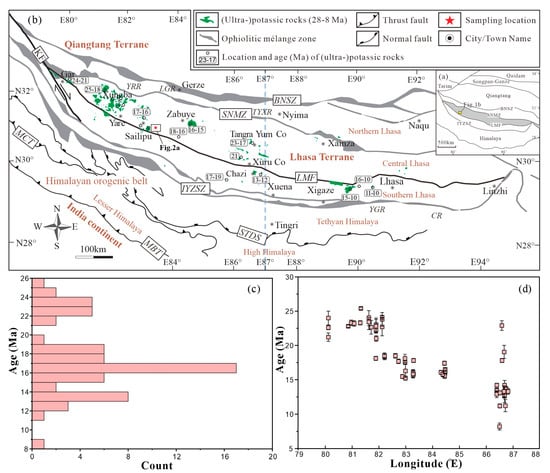
Figure 1.
(a) Simplified tectonic map of the Tibetan Plateau. (b) Tectonic framework of the southern Tibetan plateau and spatial distribution of post-collisional ultrapotassic rocks [24,25]. (c) Age histogram of the ultrapotassic rocks. (d) Ages of the ultrapotassic rocks from west to east in Tibetan plateau. Age of ultrapotassic rocks [26]. BNSZ, Bangong–Nujiang suture zone; SNMZ, Shiquan River–Nam Tso mélange zone; LMF, Luobadui–Milashan fault; KF, Karakorum fault; IYZSZ, Indus–Yarlung Zangbo suture zone; STDS, Southern Tibetan detachment system; MCT, Main central thrust; MBT, Main boundary thrust. N-S trending rift: YRR, Yare rift; LGR, Lunggar rift; TYXR, Tangra Yum Co–Xuru Co rift; YGR, Yadong-Gulu rift; CR, Cuona rift.
The ultrapotassic lamprophyre dykes in the Bangbule area contain phenocrysts of clinopyroxene, phlogopite, and feldspar that exhibit diverse compositional zonation, presenting a prime case for examining open-system magmatic processes. (This study delves into the compositional variations of the phenocrysts of several minerals and proposes a post-collisional magma mixing model to account for the petrogenesis and diversity of the Bangbule lamprophyre in the southern Tibetan Plateau.)
2. Geological Setting
The Tibetan Plateau consists of several E-W trending terranes [21] from north to south, including the Songpan–Ganzi complex, Qiangtang terrane, Lhasa terrane, and Himalayan orogenic belt, separated by the Jinsha (JSSZ), Bangong-Nujiang (BNSZ), and Indus–Yarlung Zangbo (IYZSZ) suture zones [27] (Figure 1b). As a key tectonic unit of the Himalayan–Tibetan Plateau orogen, the Lhasa terrane is divided into northern (NL), central (CL), and southern (SL) subterranes, separated by the Shiquan River–Nam Tso Mélange Zone (SNMZ) and Luobadui–Milashan Fault (LMF), respectively [25,28] (Figure 1b).
The northern Lhasa terrane comprises Middle Triassic–Cretaceous sedimentary rocks, extensive Early Cretaceous volcanic rocks and volcano-sedimentary strata, and Cretaceous granite batholiths [25,28,29]. The central Lhasa terrane consists of the Precambrian crystalline basement, Cambrian–Permian sedimentary rocks, Late Jurassic–Early Cretaceous volcanic rock-bearing sedimentary strata [25,30], and localized Mesozoic and Cenozoic metamorphic rocks [31,32]. The southern Lhasa terrane is characterized by the juvenile crust and minor Precambrian crystalline basement, predominantly composed of Cretaceous-Tertiary Gangdese batholiths, Paleogene Linzizong volcanic succession, and some Triassic-Cretaceous volcanic-sedimentary rocks exposed in the eastern region [28], (Figure 1b).
Cenozoic ultrapotassic rocks in the western central Lhasa terrane are prominently exposed in the Gar, Xungba, Sailipu, Zhabuye, Tangra Yumco, Xuru Co, and Chazi areas (Figure 1b), forming a linear belt north of the IYZSZ [26]. Ultrapotassic mafic magmatism within the Lhasa terrane mainly occurs west of 87° E, while more evolved potassic magmatism is distributed throughout the terrane [26]. These ultrapotassic rocks are developed in the Miocene, which is consistent with the time of the post-collision extension (N-S rifting or graben) of the Lhasa terrane [24,33,34]. The age of the ultrapotassic magmatism ranges from 25 to 8 Ma and shows a decreasing trend from north to south and from west to east [26] (Figure 1c,d).
The ultrapotassic rocks comprise both extrusive and intrusive facies. The extrusive facies, in the form of lava, unconformably overlie Meso/Paleo-Cenozoic volcanic sedimentary strata [35]. The intrusive bodies emplaced into Gangdese granite batholiths, Linzizong volcanic succession, and underlying sedimentary formations as dykes. Mantle-derived xenocrysts and xenoliths composed of olivine, orthopyroxene, clinopyroxene, and spinel are found in the ultrapotassic volcanic fields of Xungba and Sailipu [24,35]. Additionally, crustal xenoliths are prevalent in the ultrapotassic volcanic rocks of the central Lhasa terrane [36].
The Bangbule Zn-Pb skarn deposit is located in the western portion of the N-S-trending Lunggar rift, near the Sailipu basin (Figure 1b). Lamprophyre samples in this study were all collected from drill cores in this deposit. Stratigraphic units exposed in this area include the Middle-Upper Devonian Chaguoluoma Formation, the Late Carboniferous-Early Permian Laga Formation, and the Quaternary (Figure 2a). The Chaguoluoma Formation in the Bangbule area primarily consists of limestone, which has been largely metamorphosed into marble. The Laga Formation is characterized by clastic rocks, including siltstone, slate, pebbled siltstone, and pebbled sandstone. Quartz porphyry, occurring as stocks or veins, typically intrudes into limestone and captures wall rocks [37]. The lamprophyre dykes were emplaced into quartz porphyry and carbonate rocks (Figure 2b and Figure 3a), with contact zones frequently fragmented, indicating lamprophyre intrusion into the wall rocks (Figure 3a).

Figure 2.
Geological map of the Bangbule deposit (a) and the No. 35 geological cross section of the deposit (b).
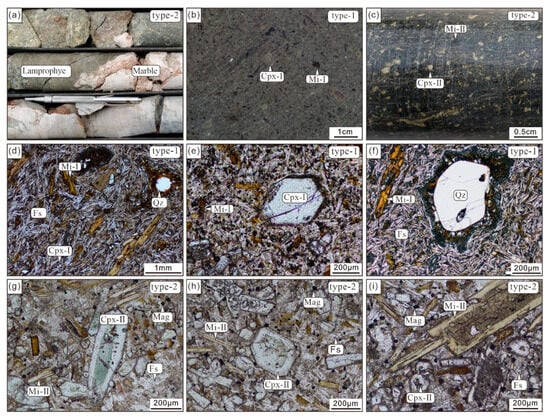
Figure 3.
Photomicrographs showing the petrographic characteristics of the Bangbule lamprophyres. (a) Lamprophyre intruded into marble, from drillhole ZK3503 (351 m). (b) Hand-specimen photograph of type-1 lamprophyre from drillhole ZK3502 (185.5 m). (c) Hand-specimen photograph of type-2 lamprophyre from drillhole ZK3503 (347.5 m). (d) Euhedral platy biotite phenocrysts in lamprophyre with quartz xenocrysts, plane-polarized light. (e,f) Clinopyroxene and biotite phenocrysts in a groundmass of feldspar. Clinopyroxene has a dominating green core and a thin colorless rim, plane-polarized light. (g,h) Clinopyroxene and phlogopite phenocrysts in lamprophyre, clinopyroxene consist of a green core and a colorless surrounding mantle, plane-polarized light. (i) Mica shows a zonation characteristic in a plane-polarized light that consists of a darker core and a lighter rim. Abbreviations: Cpx, clinopyroxene; Mi, mica; Fs, feldspar; Mag, magnetite; Qz, quartz.
3. Petrography
The selected lamprophyres were fresh, unaltered, and unmetamorphosed. Based on the differences in host rocks and mineral compositions, the Bangbule lamprophyre can be divided into type-1 and type-2 (Figure 3b,c).
Type-1 is porphyritic, with phenocrysts of mica (biotite, Mi-I) and minor clinopyroxene (Cpx-I). The mica, the sole hydrous mineral phase, typically appears as euhedral platy phenocrysts or microphenocrysts, with some displaying zoning (Figure 3e). Some clinopyroxene crystals exhibit a dominant green core and a thin colorless rim, while others merely display an irregular green core. The groundmass of type-1 lamprophyres mainly consists of K-feldspar, alongside accessory apatite and Fe-Ti oxides (Figure 3d,e). Notably, quartz xenocrysts up to 2 mm in size were observed in this type and show typically melting corrosion structure (Figure 3f).
Type-2 lamprophyre has abundant lath-shaped phenocrysts of mica (phlogopite and annite, Mi-II) and clinopyroxene (Cpx-II). The clinopyroxene phenocrysts are euhedral to subhedral and comprise a green core and a colorless mantle rim under the microscope. The green cores often have irregular or embayed shapes (i.e., resorption/dissolution textures) and sharp boundaries with their mantles/rims (Figure 3g,h). The dark grey annite core is enclosed by the light brown phlogopite rim (Figure 3i). K-feldspar forms microcrystalline laths and constitutes the groundmass with sparse apatite and Fe-Ti oxides. In comparison, the abundance of K-feldspar as groundmass in type-2 lamprophyres is much lower than in type-1.
4. Analytical Methods
4.1. Whole-Rock Geochemical Analysis
Major and trace element analyses of the samples were conducted at the Beijing GeoAnalysis Co., Ltd., China. First, the samples were finely crushed to <200 mesh using an agate mill. After ultrasonic cleaning in distilled water, they were dried and ground into powders. Major elements were quantified using X-Ray fluorescence spectrometry (XRF), achieving an accuracy better than 3%. The compositions of trace elements, including rare earth elements (REEs), in the whole-rock samples were determined using an Agilent-7900 inductively coupled plasma mass spectrometer (ICP-MS) manufactured by Agilent Technologies, Santa Clara, CA, USA, with an estimated analytical accuracy of <10%. Loss on ignition (LOI) was measured as the weight loss of the samples after they were baked for one hour at a constant temperature of 1000 °C in a muffle furnace. Whole-rock fluorine (F) concentration was analyzed using the ion-selective electrode method detailed by He et al. [37].
4.2. Whole-Rock Sr–Nd Isotopic Analysis
Whole-rock Sr and Nd isotopic compositions were analyzed using a NEPTUNE Plus multi-collector inductively coupled plasma mass spectrometer (MC-ICP-MS) manufactured by Thermo Fisher Scientific, Waltham, MA, USA. The measurements were conducted at Beijing GeoAnalysis Co., Ltd., China, with the instrument operating in static mode. Before sample analysis, the parameters of the Neptune Plus MC-ICP-MS, including the plasma portion (e.g., the torque tube position and carrier gas flow rate) and ion lens settings, were optimized using NIST 987 (Sr 200 μg/L) and Thermo Fisher Tuning Fluid (Nd 200 μg/L) standard solutions to maximize the sensitivity. After chemical separation, the samples were introduced into the mass spectrum with 2% HNO3 using the free atomization method, ensuring that the signal intensity for 88Sr and 146Nd was about 8 V (corresponding to Sr and Nd concentrations of approximately 200 μg/L). The injection system was flushed with 2% HNO3 solution prior to analyzing subsequent samples. The raw data of isotopic ratios were corrected for mass fractionation by normalizing to 88Sr/86Sr = 8.375209 for Sr and 146Nd/144Nd = 0.7219 for Nd, following the exponential law. The initial 87Sr/86Sr and 143Nd/144Nd ratios were calculated based on the 40Ar/39Ar dating results.
4.3. Mica 40Ar-39Ar Dating
Mica (phlogopite) grains from type-2 lamprophyres were crushed and sieved to 40–80 μm and then meticulously handpicked under a binocular microscope for >99% purity at the Analytical Laboratory of the Hebei Institute of Regional Geology and Mineral Resources Survey, Langfang, China. Following ultrasonic cleaning, the samples were sealed in a quartz tube and wrapped with 1 mm thick cadmium skin for irradiation in an HFETR reactor for 24 h at the Chinese Institute of Atomic Energy, Beijing, China. After cooling to safe radiation levels, 40Ar/39Ar dating via stepwise heating was conducted at the Analytical Laboratory Beijing Research Institute of Uranium Geology, Beijing, China. During analysis, gas was released from samples through stepwise heating (800 to 1400 °C), and the gas released from each stage was purified using an NG PREP SYSTEM equipped with a Zr-Al pump (ThermoFisher Scientific, Waltham, MA, USA). The Ar isotopic composition was measured using an Argus VI noble gas mass spectrometer (ThermoFisher Scientific, Waltham, MA, USA). Argon isotopic interferences from K and Ca were assessed through irradiation of K2SO4 and CaF2 pure salts, yielding correction factors of (36Ar/37Ar)ca = 0.0008057, (39Ar/37Ar)ca = 0.000713, and (40Ar/39Ar)k = 0.00213. The neutron flux gradient was determined using Fangshan biotite ZBH-25 (age: 132.7 ± 1.2 Ma, K content: 7.6%) in the quartz tube, with the irradiation constant of the sample calculated at J = 0.0005914. The mass discrimination factor of the mass spectrometer was derived from atmospheric argon’s isotopic composition, with the 40K decay constant set at λ = 5.543 × 10−10 a−1 [38]. Data reduction and plotting were performed using ArArCalc software© v2.4 [39]. Plateau ages distributed over at least 3 contiguous stages, with errors within 1σ.
4.4. Mineral Chemical Analysis and X-Ray Elemental Maps
Composition of pyroxene, mica, and feldspar were analyzed on polished thin sections using electron probe microanalysis (EPMA) technique at the Guangzhou Institute of Geochemistry, Chinese Academy of Sciences. The experiments were conducted using the JXA-8230 instrument manufactured by JEOL Ltd, Akishima, Japan. Backscattered electron images assisted in targeting specific analysis sites on mineral specimens. These microchemical analyses were conducted under an acceleration voltage of 15 kV and an electron beam current of 20 nA, with a beam diameter of 2 μm. Element counting lasted for 10–20 s at each peak and 5–10 s at each of two background positions. Inter-elemental effect corrections were applied using a ZAF (Z: atomic number; A: absorption; F: fluorescence) procedure.
High-resolution 2D elemental X-Ray mapping was generated for one mica and two clinopyroxene crystals and one feldspar glomerocryst. The mapping was carried out using the EPMA-1720 (manufactured by Shimadzu Corporation, Kyoto, Japan) at the Institute of Mineral Resources, Beijing General Research Institute of Mining and Metallurgy. The operational conditions included an acceleration voltage of 15 kV, a beam current of 20 nA, and a beam size of 1–5 μm. The sampling time was set at 12 ms per point. Na Ka, Mg Ka, and Al Ka were analyzed using a TAP crystal, while Ti Ka and Fe Ka were analyzed using a LIF crystal. K Ka, Ca Ka, Sr La, and Ba La were analyzed using a PET crystal, Shimadzu EPMA-1720.
5. Results
5.1. Major and Trace Elements
The data of the whole-rock major and trace elements of the studied lamprophyres are listed in Supplementary Table S1. Type-1 lamprophyres exhibit notably higher SiO2 (58.80–59.80 wt.%), Al2O3 (14.51–14.67 wt.%), and Na2O + K2O (10.08–10.22 wt.%) contents but lower TFe2O3 (4.74–5.15 wt.%), CaO (3.52–4.00 wt.%), and MgO (3.70–4.06 wt.%) contents and Mg# values (59–63) than type-2 lamprophyres (SiO2: 48.29–49.18 wt.%; Al2O3: 10.66–10.95 wt.%; Na2O + K2O: 6.90–7.41 wt.%; TFe2O3: 6.03–6.22 wt.%; CaO: 11.05–11.53 wt.%; MgO: 6.88–7.72 wt.%; Mg#: 69–71). The whole-rock geochemical data indicate that all the samples are ultrapotassic according to Foley’s criteria (Figure 4). The LOI and CaO content of type-2 lamprophyres is significantly higher than that of type-1, consistent with the dominance of hydrous minerals (mica) and the influence of carbonate wall rocks. There are negative correlations on MgO vs. Al2O3 plots, but positive correlations for plots of MgO vs. TFe2O3, Ba vs. Sr, and MgO vs. Cr (Figure 5).
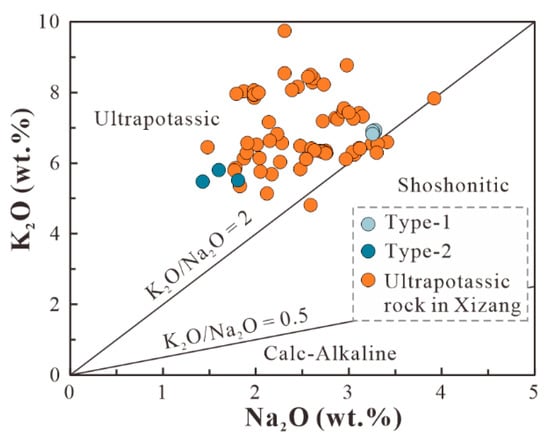
Figure 4.
Na2O (wt.%) vs. K2O (wt.%) diagram of studied lamprophyres classifying them as ultrapotassic based on major oxide geochemistry. The fields demarcating ultrapotassic from shoshonitic and shoshonitic from calc-alkaline are based on a K2O/Na2O ratio of 2.0 and 0.5, respectively [40].
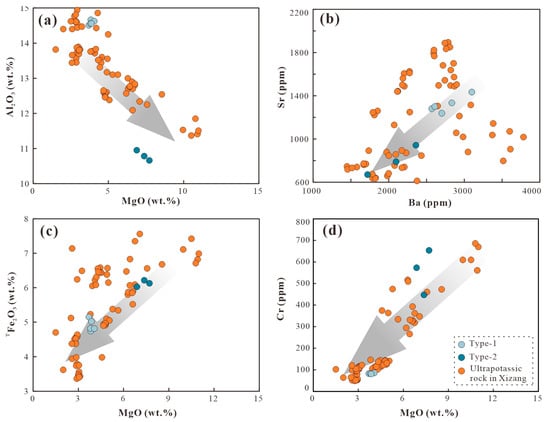
Figure 5.
Bivariate plots (a) Al2O3 (wt.%), (b) Ba (ppm) vs. Sr (ppm), (c), MgO (wt.%) vs. TFe2O3 (wt.%), (d) MgO (wt.%) vs. Cr (ppm) for lamprophyres showing good fractionation trends. The arrows indicate the direction of fractional crystallization.
The two types of lamprophyres in Bangbule area differ markedly in Cr and Ni contents. Type-1 lamprophyres have much lower Cr and Ni contents (Cr content: 81–86 ppm, Ni content: 48–51 ppm) than type-2 lamprophyres (Cr content: 477–654 ppm, Ni content: 250–356 ppm). In the chondrite-normalized REE diagram (Figure 6a), both lamprophyre types show significant enrichments in LREEs relative to HREEs overall. Nevertheless, type-1 lamprophyres are more enriched in LREEs than type-2, with LaN/YbN ratios ranging from 36.82 to 38.85 and from 22.32 to 24.71, respectively. In the primitive mantle-normalized trace element pattern (Figure 6b), both types of lamprophyres are enriched in large-ion lithophile elements (LILEs) compared to high-field-strength elements (HFSEs), with variations in some trace elements. Notably, a significant positive Pb anomaly and negative Nb, Ta, and Ti anomalies can be observed.
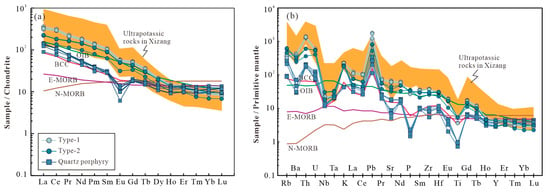
Figure 6.
Chondrite-normalized REEs patterns (a) and primitive mantle-normalized trace-element patterns (b) of the lamprophyres from Bangbule. Primitive mantle and chondrite normalizing values and the OIB, E-MORB, and N-MORB [41]. Data of BCC (bulk continental crust) [42], quartz porphyry [37], and ultrapotassic rocks from southern Tibet [43] are shown for comparison.
5.2. 40Ar-39Ar Geochronology
A stepwise thermal release analysis of mica was performed in nine heating steps, ranging from 800 °C to 1400 °C. The analytical results are presented in Supplementary Table S2. The mica sample exhibits a roughly undisturbed age spectrum, yielding plateau ages of 29.5 ± 0.2 Ma (Figure 7), isochron ages of 29.5 ± 0.2 Ma with initial 40Ar/36Ar ratios of 270 ± 43 (Figure 7), and inverse isochron ages of 29.6 ± 0.2 Ma with initial 40Ar/36Ar ratios of 262 ± 38. Compared with other ultrapotassic rocks in Xizang, the Bangbule lamprophyre is slightly older (Figure 1c).
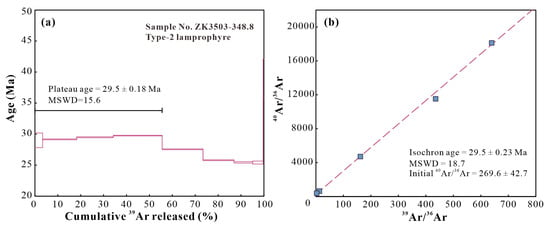
Figure 7.
40Ar/39Ar geochronological diagrams showing the plateau age (a) and isochron age (b) of the mica (phlogopite) from type-2 lamprophyre. The red solid line indicate yielding plateau ages, and the blue squares indicate the age data corresponding to the 39Ar released during the heating process.
5.3. Whole-Rock Sr–Nd Isotopes
The initial Sr–Nd isotopic ratios of the lamprophyre samples were corrected to an emplacement age of 30 Ma. These lamprophyre samples have high initial Sr and low Nd isotopic ratios. The initial 87Sr/86Sr ratios varies from 0.713936 to 0.716999, and the consistent initial 143Nd/144Nd isotopic ratios (0.511991–0.512012, Figure 8, Supplementary Table S3). The remarkable consistency in the initial 143Nd/144Nd ratios suggests a similar source for all the samples. Depleted mantle Nd model ages (TDM) ranging from 1.73 to 1.92 Ga, which is consistent with those of ultrapotassic rocks from the Lhasa terrane previously reported [24,25,26] (1.33–3.04 Ga).
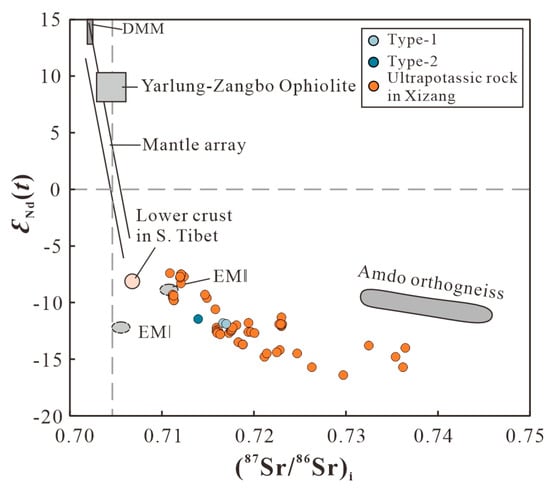
Figure 8.
The diagram of (87Sr/86Sr)i vs. εNd(t) for the Bangbule lamprophyres and post-collisional ultrapotassic rocks in southern Tibet. Data sources: Mantle reservoirs, DMM, EMI, and EMII [44]. Yarlung Zangbo ophiolite [43,44,45,46,47]. Lower crust of south Tibet [45]. Amdo orthogneiss from (i.e., the upper continental crust of Tibet) [46]. Sr–Nd isotopes of ultrapotassic rocks [24,25,26].
5.4. Mineral Compositions
Clinopyroxene in the two types of lamprophyres differ in chemical compositions, as shown by electron probe microanalysis (Supplementary Table S4). Cpx-I has significantly lower Mg# values (63–66) but higher Al2O3/TiO2 ratios (8.33–18.34) compared to both zoned and unzoned Cpx-II (Mg#: 76–90, Al2O3/TiO2: 1.80–6.78). They also show differences in other major elements like SiO2, MnO, and Na2O. The clinopyroxene are diopsidic, with Wo42-43En36-37Fs20-22 for type-1 and Wo41-45En42-52Fs6-14 for type-2 (Figure 9a). The green-core clinopyroxene exhibits reverse zoning, with cores characterized by higher Fe, Al, and Na contents but lower Mg content than their mantles, which is in contrast to the normal zoning of clinopyroxene (higher Mg# in core), as indicated by elemental maps (Figure 10). Furthermore, Cpx-I’s composition roughly matches Cpx-II’s core composition.
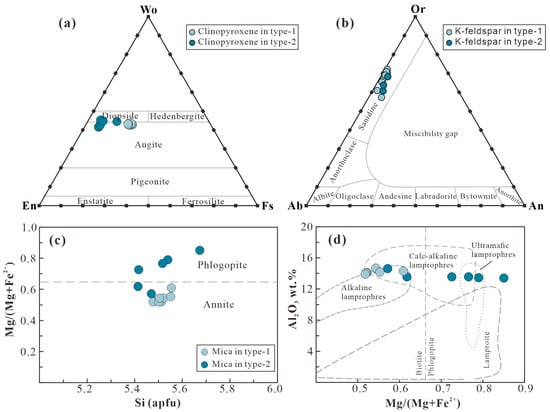
Figure 9.
(a) En–Wo–Fs classification diagram for clinopyroxene of Bangbule lamprophyres [47]. (b) Triangular plot for classification of the feldspar of Bangbule lamprophyre [48]. (c) Mica of the studied samples on Si (apfu) vs. Mg# diagram [49] and (d) Mg# vs. Al2O3 diagram [50]. Samples are classified as annite and phlogopite, respectively, and showing affinity to both the global calc-alkaline and alkaline lamprophyres.
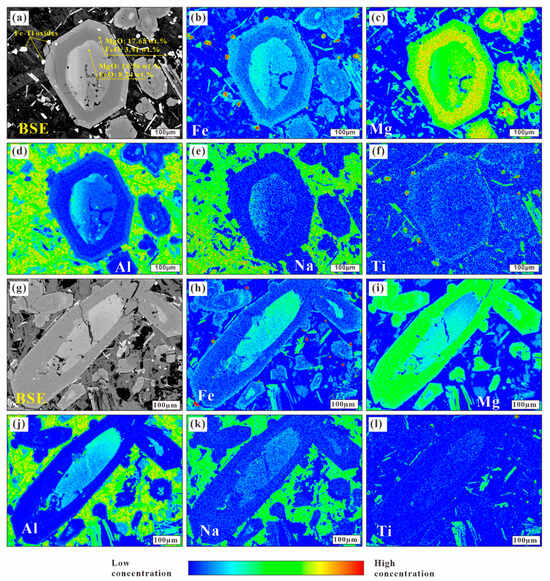
Figure 10.
(a,g) Backscattered electron image of clinopyroxene phenocryst of type-2 lamprophyre. (b–f,h–l) EPMA elemental X-Ray maps of the studied Bangbule euhedral clinopyroxene phenocryst of type-2 lamprophyre. The grayscale and false-color compositional images illustrate the distinctive differences between the core and mantle in major elements.
The two lamprophyre types have similar feldspar compositions. Feldspar phenocrysts of type-1 lamprophyre have Or, An, and Ab contents varies from 57.3 to 72.1, 1.1 to 5.9, and 26.8 to 37.0, respectively. The Or, An, and Ab contents of type-2 are 49.2–68.2, 3.3–31.3, and 19.5–34.4, respectively (Supplementary Table S5). Except for one analysis spot, all analysis spots are classified as orthoclase-sanidine on the An-Ab-Or diagram (Figure 9b), indicating a predominance of alkali-feldspar over plagioclase. Alkali-feldspars in type-1 lamprophyres show zonation, with cores enriched in K, Sr, and Ba but depleted in Na and Ca compared to their rims (Ba-rich K-feldspar, Supplementary Figure S1).
Mica from the two lamprophyre types also varies in chemical composition; III contains 11.52–13.31 wt.% MgO, 5.23–19.22 wt.% FeO, and 4.18–4.75 wt.% TiO2 and has an Mg# of 52–61 (average = 54). In contrast, IIII contains 12.94–21.2 wt.% MgO, 6.60–17.29 wt.% FeO, and 3.06–6.44 wt.% TiO2 and has an Mg# of 57–85 (average = 72) (Supplementary Table S6). The two mica types are classified as annite and phlogopite on the Si (apfu) vs. Mg/(Mg + Fe2+) and Mg/(Mg + Fe2+) vs. Al2O3 diagrams (Figure 9c,d), respectively. Mi-II’s cores exhibit higher iron and titanium contents but lower magnesium contents than its rims (Supplementary Figure S2), with no notable differences in other major elements (e.g., Al and Na).
5.5. T-P Conditions
In this study, we estimated the pre-intrusive temperatures and pressures of magma reservoirs beneath Bangbule using published clinopyroxene-only [51] and biotite-only thermobarometers [52]. P-T estimates were made using the clinopyroxene-only thermobarometer (Equations 32a and 32d) for lamprophyres. See Li and Zhang [52] for more details.
The calculated crystallization temperatures and pressures of Cpx-I are (1190–1220 °C) and 12.6–15.5 kbar (corresponding to a paleodepth of 47–58 km, avg. = 52; assuming 3.75 km/kbar as the pressure gradient; Table 1), whereas those of Cpx-II have ranges of (1220–1270 °C) and 4.4–14.1 kbar (16–53 km paleodepth). The pressure of the core of green-core clinopyroxene is high (14.1 kbar, 53 km palaeodepth), while other pressure values are relatively low and in a narrow range (4.4–9.5 kbar, 16–36 km palaeodepth, avg. = 24). These results are consistent with those of Li et al. [36]. Mi-I has temperatures of (820–850 °C) and pressures of 2.9–4.4 kbar (11–16 km palaeodepth, avg. = 15), and Mi-II has temperatures of (850–990 °C) 851–992 °C and pressures of 4.2–5.8 kbar (16–22 km palaeodepth, avg. = 18; Table 1). Overall, Cpx-I and Mi-I temperatures are lower than Cpx-II and Mi-II, respectively.

Table 1.
Statistical Table of Clinopyroxene—Biotite Core—Rim Analysis Results.
6. Discussion
6.1. Crustal Contamination
It is imperative to evaluate potential crustal contamination effects on melt compositions before discussion mantle source characteristics and petrogenetic processes. Critical petrogenetic evidence includes: (1) entrainment phenomena of quartz xenocrysts within type-1 lamprophyre dykes, demonstrating crustal interaction during magma ascent; and (2) anomalously elevated LOI in type-2, suggesting the influence of contamination by volatile-rich crustal materials. Therefore, the influence of crustal contamination cannot be neglected.
Firstly, the high SiO2 content in Type-1 lamprophyre (∼59 wt.%) is likely attributed to crustal contamination during magma intrusion into quartz porphyry. This conclusion is supported by petrographic evidence of quartz xenocrysts with resorbed textures (Figure 3f). In contrast, type-2 lamprophyres display significantly high CaO contents (∼11 wt.%) compared to type-1 (∼4 wt.%), potentially reflecting limestone contamination during emplacement. The limited variation of Nb/Y (0.78–1.11), Th/La (0.89–1.51) and Nb/Ta (13.8–18.9) and the enrichment of incompatible elements and light rare earth elements (LREEs) relative to both continental crust and quartz porphyry (Figure 6) indicate that crustal contamination would have a limited effect on the trace elements compositions of these rocks. Isotopic constraints further corroborate limited crustal influence, with both lamprophyre types exhibiting restricted 87Sr/86Sr (0.7136–0.7170) and 143Nd/144Nd (0.51201–0.51204) ranges that align with Tibetan ultrapotassic rocks (Figure 8). Collectively, these findings demonstrate that crustal contamination exerts substantial influence on major element geochemistry but shows negligible effects on trace element distributions (particularly high field strength elements) and radiogenic isotope systematics in Bangbule lamprophyres.
6.2. Nature of the Source Region
The MgO-Al2O3 negative covariation, Sr-Ba positive correlation, and week Eu anomalies (Eu/Eu* = 0.65–0.76) (Figure 5c,d and Figure 6a) suggest that the plagioclases were not a major residual phase in the magma source region of Bangbule lamprophyres. These lamprophyre samples exhibit diagnostic ultrapotassic signatures characterized by elevated K2O contents and pronounced large-ion lithophile element (LILE) enrichment (the high Rb/Sr (0.16–0.47) but low Ba/Rb (5.63–13.47) ratios in both type-1 and type-2), indicative of derivation from a hydrous, volatile-bearing, K-rich mantle source containing mineral phases such as phlogopite or amphibole [53]. The high Rb/Sr (0.16–0.47) but low Ba/Rb (5.63–13.47) ratios in both type-1 and type-2 (Figure 11a) suggest the presence of phlogopite rather than amphibole in the melting source [54]. This is also demonstrated by the enrichment of K2O relative to Na2O in the sample, as partial melting of the phlogopite-bearing mantle generates ultrapotassic melts with K2O/Na2O > 2 [24].
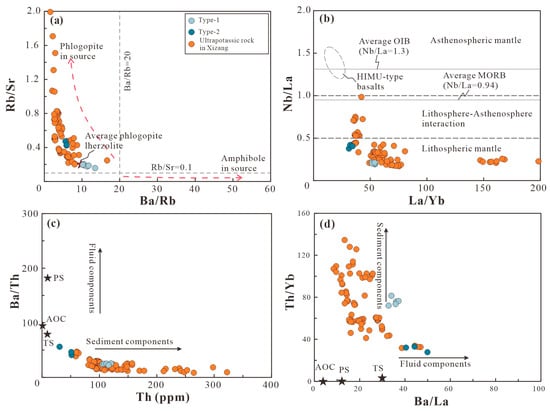
Figure 11.
(a) Ba/Rb vs. Rb/Sr diagram [54]. Average phlogopite lherzolite [55]. The red dashed arrow indicates the source region (b) La/Yb vs. Nb/La variation in the studied lamprophyres showing their affinity to the lithospheric mantle [55]. The average Nb/La values for MORB and OIB [41]. (c) Th vs. Ba/Th, and (d) Ba/La vs. Th/Yb diagrams. The compositions of altered oceanic crust (AOC), terrestrial sediments (TS), and pelagic sediments (PS) [56].
The analyzed samples exhibit enrichment in incompatible elements such as LREEs and LILEs and depletion in HFSEs (especially Nb, Ta, and Ti) relative to neighboring trace elements (Figure 6). Generally, the decompressional melting of the asthenospheric mantle produces normal mid-oceanic ridge basalt (MORB) depleted in LREEs and LILEs [57] and positive Nb-Ta-Ti anomalies, contrasting with the characteristics of Bangbule lamprophyres (Figure 6). The low Nb/La (0.19–0.42) and La/Yb (31–54) ratios in the samples indicate an affinity for lithospheric mantle-derived melts [58] (Figure 11b), suggesting a lithospheric mantle origin of the Bangbule lamprophyres, which is supported by the high Ni (250–356 ppm) and Cr (477–654 ppm) concentrations and high Mg# (69–71) in type-2 lamprophyre. Both type-1 and type-2 lamprophyre have enriched Sr-Nd isotope composition with old TDM ages (from 1.73 to 1.92 Ga), which are similar with other ultrapotassic rocks in Lhasa terrane that source from the metasomatic mantle during Indian continental subduction [24,59]. Given their high abundance of Ba, K, Pb, Sr, Li, and LREEs and the high Ba/La and Th/Yb ratios in the lamprophyre dykes (Figure 11c,d), it is more likely that the Bangbule lamprophyre originated from a metasomatic mantle with involvement of sediment melt-like components during Indian–Asia collision [60,61].
6.3. Petrogenesis
6.3.1. Fractional Crystallization
The studied lamprophyres exhibit geochemical co-variation trends with other ultrapotassic rocks in Lhasa terrane (Figure 5), supporting fractional crystallization as a key petrogenetic process [62]. Type-1 lamprophyres show significantly lower TiO2 and P2O5 concentrations compared to type-2 counterparts, which can be attributed to early-stage fractionation of Fe-Ti oxides and apatite, respectively (Supplementary Table S1). The depleted Cr (81–86 ppm) and Ni (48–51 ppm) contents in type-1 lamprophyres relative to primitive mantle values suggest fractional crystallization of spinel and olivine during magma evolution. The positive correlations between MgO and TFe2O3 contents, as well as between Ni and Cr (Figure 5), suggest that the fractionation phases were dominated by mafic minerals such as olivine and clinopyroxene. This aligns with the abundance of clinopyroxene phenocrysts observed in both types of lamprophyres. Furthermore, the lower Mg# values (63–66) coupled with high Al2O3 concentrations of the Cpx-I phenocryst in type-1 lamprophyre (Supplementary Table S4) provide direct mineralogical evidence for advanced crystal fractionation in the parental magmas.
6.3.2. Magma Replenishment and Mixing
Mineral zoning typically correlates with magma composition, physicochemical condition changes, and magmatic processes like fractional crystallization, mixing, and recharge [63]. In this study, feldspar, clinopyroxene, and mica crystals exhibit clear compositional and textural zoning (Figure 10, Supplementary Figure S1). Pyroxene reverse zoning can be attributed to (1) magma mixing between co-genetic or distinct batches, (2) pulsed magma replenishment from the source, and (3) diffusion-related re-equilibration [63,64,65].
The following evidence indicates that Type-1 lamprophyre’s magma was replenished with a more mafic co-genetic magma: (1) the consistent Sr-Nd isotopic characteristics of type-1 and type-2 lamprophyres suggest a common source region (Figure 8), (2) resorption of feldspar and clinopyroxene cores in Type-1 lamprophyres indicates entrapment by a high-temperature, primitive melt, (3) sharp contrasts in Ba, K, Na, Sr, and Ca contents between cores and rims (Supplementary Figure S1) rule out diffusion-related re-equilibration, which would cause gradual compositional changes, (4) reversely zoned clinopyroxene crystals with higher Mg# in the rims indicate compositional similarity of the magmas [66,67], and (5) the occurrence of micro-ilmenite enclosed by magnetite (Figure 10b,f,h,l) suggests changes in melt composition [68].
Considering the distinct petrographic features and chemical variations in Fe, Mg, Cr, and Ni, the heterogeneity of type-1 and type-2 lamprophyric melts in the Bangbule area is likely caused by the replenishment of a mafic magma and associated magma mixing.
Therefore, mineral textures and geochemical evidence indicate that the Bangbule lamprophyre underwent magma replenishment and mixing during its evolution. Barometric calculations reveal that the rim of green-core clinopyroxene (Cpx-2) crystallized at a depth of ~29 km, while its core formed ~53 km below the paleo-surface, suggesting a two-stage magmatic evolution. Combined with prior discussions, we propose the following sequence: Initially, the early-stage Bangbule lamprophyre magma reservoir experienced crystallization differentiation of mafic minerals (e.g., pyroxene and olivine) at ~52 km depth before ascending to a shallow level. Subsequently, a more mafic magma with high Mg# values intruded into the shallow magma reservoir at ~29 km depth, triggering magma mixing. During this process, early-formed minerals underwent resorption and developed mafic overgrowths [69], resulting in reverse-zoned phenocrysts. As the hybrid magmas continued to evolve, K-feldspar mantles or rims formed on the earlier resorbed, Ba-rich cores. In the shallow magma reservoir (the final emplacement site), mineral phases underwent gravitational sorting and accumulation, with interstices between cumulate minerals filled by late-stage K-feldspar and groundmass. Ultimately, the emplacement of this heterogeneous magma in the Bangbule area produced both type-1 and type-2 lamprophyres.
6.4. Implications for Ore Genesis of Porphyry Deposit in Gangdese
Previous studies have proposed that the fluid exsolution from the Miocene ultrapotassic magma during the magma mixing is a key process in the generation of post-collision porphyry Cu-Au deposits in Xizang [70,71]. Zhou et al. [40] proposed that the ultrapotassic magma may have high contents of Cl, which can be added into the porphyry system through magma mixing at shallow magma chamber. Furthermore, Wang et al. [41] also argued that the injection of water-enriched ultrapotassic magma into the felsic magma has played an important role in generation of fertile magmas with high water content and high oxygen fugacity in the Gangdese belt. Hence, the ultrapotassic magma played an important role in formation of giant porphyry deposit in the post-collision setting. From preceding discussion, we propose a magma recharge and mixing model for the petrogenesis of the ultrapotassic magmatism during its ascent (Figure 12). The late stage more mafic magma generally has distinct chemical compositions with the primary ultrapotassic magma [36]. Therefore, recharge of mafic magma is also important to form the fertile ultrapotassic magma and related porphyry deposit in Gangdese belt by changing its chemical composition, water contents, and temperature. Considering that the ultrapotassic magmatism in the Lhasa terrane has wide range of formation ages (~30 to 10 Ma) even in the same place, the later formed ultrapotassic rocks may have experienced more complex recharge and mixing processes, favoring formation of porphyry deposits.
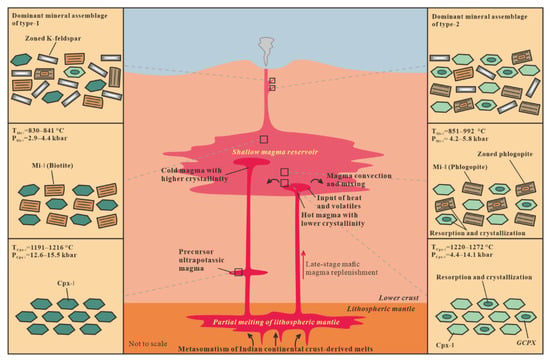
Figure 12.
Schematic model of magma mixing and phenocryst evolution for the Bangbule ultrapotassic lamprophyre dykes. The black arrows indicate magma convection and mixing.
7. Conclusions
The Bangbule lamprophyre dykes can be classified into two types based on their mineralogy, mineral modes, and bulk-rock geochemistry. New mica 40Ar-39Ar dating of type-2 (basaltic) lamprophyres suggests their emplacement at ca. 30 Ma. The primitive ultrapotassic lamprophyre magmas originated from the partial melting of the lithospheric mantle in Tibet, which consists of phlogopite-bearing mantles. Both types likely evolved through varying degrees of fractional crystallization involving mafic mineral phases in the early stage of magma evolution. The overgrowth of mantles with high Mg# values on clinopyroxene and biotite phenocrysts indicate a recharge of late-stage mafic magma. Clinopyroxene- and biotite-only thermobarometry calculations suggest a multi-level magma mixing model, in which the recharge of mafic magma changes the chemical composition, water content, and temperature of the fertile ultrapotassic magma, favoring the formation of giant porphyry deposits in the Gangdese Belt.
Supplementary Materials
The following supporting information can be downloaded at: https://www.mdpi.com/article/10.3390/min15040332/s1, Figure S1: Backscattered electron (BSE) image and EPMA elemental X-Ray maps of the studied Bangbule feldspar phenocryst of type-1 lamprophyre. The grayscale and false-color compositional images reveal the core and rim are obviously different in composition. Figure S2: Backscattered electron (BSE) image and EPMA elemental X-Ray maps of the studied mica phenocryst of Bangbule type-2 lamprophyre. The grayscale and false-color compositional images show compositional differences between the core and the rim; Table S1: Major and trace elements of the Bangbule lamprophyres. Table S2: 40Ar/39Ar stepwise heating analytical data of mica from the Type-2 lamprophyre. Table S3: Sr–Nd isotope composition of the Bangbule lamprophyres and ultrapotassic rocks from southern Tibet. Table S4: Major element compositions of the clinopyroxenes in lamprophyre. Table S5: Major element compositions of the feldspar in lamprophyre. Table S6: Major element compositions of the mica in lamprophyre. Ref. [72] is cited in Supplementary Materials.
Author Contributions
Conceptualization, Y.W. (Yong Wang) and C.H. (Chuankai He); methodology, Y.W. (Yong Wang) and C.H. (Chenyu Hong); software, C.H. (Chenyu Hong), S.X. and R.C.; validation, Y.W. (Yong Wang), Y.W. (Yongqiang Wang) and S.Z.; formal analysis, C.H. (Chenyu Hong); investigation, Y.B., P.Y. and D.C.; resources, S.Z. and H.W.; data curation, S.X. and R.C.; writing—original draft preparation, C.H. (Chenyu Hong); writing—review and editing, Y.W. (Yong Wang); visualization, C.H. (Chenyu Hong) and S.X.; supervision, Y.W. (Yong Wang) and H.W.; project administration, Y.W. (Yong Wang) and C.H. (Chuankai He). All authors have read and agreed to the published version of the manuscript.
Funding
This research was jointly supported by National Natural Science Foundation of China (Nos. 42302098, 42230813), the National Key Research and Development Project of China (No. 2022YFC2905002), and the Open Fund from SinoProbe Laboratory (Grant No.: SL202415).
Data Availability Statement
Data are contained within the article and Supplementary Materials.
Conflicts of Interest
The authors declare no conflicts of interest.
References
- Mo, X.X.; Niu, Y.L.; Dong, G.C.; Zhao, Z.D.; Hou, Z.Q.; Zhou, S.; Ke, S. Contribution of syncollisional felsic magmatism to continental crust growth: A case study of the Paleogene Linzizong volcanic succession in southern Tibet. Chem. Geol. 2008, 250, 49–67. [Google Scholar]
- Chen, J.S.; Huang, B.C.; Sun, L.S. New constraints to the onset of the India-Asia collision: Paleomagnetic reconnaissance on the Linzizong Group in the Lhasa Block, China. Tectonophysics 2010, 489, 189–209. [Google Scholar]
- Gibbons, A.D.; Zahirovic, S.; Müller, R.D.; Whittaker, J.M.; Yatheesh, V. A tectonic model reconciling evidence for the collisions between India, Eurasia and intra-oceanic arcs of the central-eastern Tethys. Gondwana Res. 2015, 28, 451–492. [Google Scholar]
- Westerweel, J.; Roperch, P.; Licht, A.; Dupont-Nivet, G.; Win, Z.; Poblete, F.; Ruffet, G.; Swe, H.H.; Thi, M.K.; Aung, D.W. Burma Terrane part of the Trans-Tethyan arc during collision with India according to palaeomagnetic data. Nat. Geosci. 2019, 12, 863. [Google Scholar]
- Kapp, P.; DeCelles, P.G.; Gehrels, G.E.; Heizier, M.; Ding, L. Geological records of the Lhasa-Qiangtang and Indo-Asian collisions in the Nima area of central Tibet. Geol. Soc. Am. Bull. 2007, 119, 917–933. [Google Scholar]
- Tan, X.D.; Gilder, S.; Kodama, K.P.; Jiang, W.; Han, Y.L.; Zhang, H.; Xu, H.H.; Zhou, D. New paleomagnetic results from the Lhasa block: Revised estimation of latitudinal shortening across Tibet and implications for dating the India-Asia collision. Earth Planet. Sci. Lett. 2010, 293, 396–404. [Google Scholar]
- Hu, X.M.; Wang, J.G.; BouDagher-Fadel, M.; Garzanti, E.; An, W. New insights into the timing of the India-Asia collision from the Paleogene Quxia and Jialazi formations of the Xigaze forearc basin, South Tibet. Gondwana Res. 2016, 32, 76–92. [Google Scholar]
- Owen, J.P. Geochemistry of lamprophyres from the Western Alps, Italy: Implications for the origin of an enriched isotopic component in the Italian mantle. Contrib. Mineral. Petrol. 2008, 155, 341–362. [Google Scholar]
- Huang, F.; Chen, J.L.; Xu, J.F.; Wang, B.D.; Li, J. Os–Nd–Sr isotopes in Miocene ultrapotassic rocks of southern Tibet: Partial melting of a pyroxenite-bearing lithospheric mantle? Geochim. Cosmochim. Acta 2015, 163, 279–298. [Google Scholar] [CrossRef]
- Pandey, A.; Rao, N.V.C.; Chakrabarti, R.; Pankaj, P.; Pandit, D.; Pandey, R.; Sahoo, S. Post-collisional talc-alkaline lamprophyres from the Kadiri greenstone belt: Evidence for the Neoarchean convergence-related evolution of the Eastern Dharwar Craton and its schist belts. Lithos 2018, 320, 105–117. [Google Scholar]
- Ubide, T.; Mollo, S.; Zhao, J.X.; Nazzari, M.; Scarlato, P. Sector-zoned clinopyroxene as a recorder of magma history, eruption triggers, and ascent rates. Geochim. Cosmochim. Acta 2019, 251, 265–283. [Google Scholar]
- Humphreys, M.C.S.; Blundy, J.D.; Sparks, R.S.J. Magma evolution and open system processes at Shiveluch Volcano: Insights from phenocryst zoning. J. Petrol. 2006, 47, 2303–2334. [Google Scholar]
- Xing, C.M.; Wang, C.Y. Periodic mixing of magmas recorded by oscillatory zoning of the clinopyroxene macrocrysts from an ultrapotassic lamprophyre dyke. J. Petrol. 2020, 61, egaa103. [Google Scholar]
- Nomade, S.; Renne, P.R.; Mo, X.X.; Zhao, Z.D.; Zhou, S. Miocene volcanism in the Lhasa block, Tibet: Spatial trends and geodynamic implications. Earth Planet. Sci. Lett. 2004, 221, 227–243. [Google Scholar]
- Foley, S. Vein-plus-wall-rock melting mechanisms in the lithosphere and the origin of potassic alkaline magmas. Lithos 1992, 28, 435–453. [Google Scholar]
- Yang, Z.M.; Goldfarb, R.; Chang, Z.S. Generation of Postcollisional Porphyry Copper Deposits in Southern Tibet Triggered by Subduction of the Indian Continental Plate; Special Publication 19; Society of Economic Geologists: Denver, CO, USA, 2016; pp. 279–300. [Google Scholar]
- Zindler, A.; Hart, S.R. Chemical geodynamics. Annu. Rev. Earth Plant. Sci. 1986, 14, 493–571. [Google Scholar]
- Miller, C.; Thöni, M.; Frank, W.; Schuster, R.; Melcher, F.; Meisel, T.; Zanetti, A. Geochemistry and tectonomagmatic affinity of the Yungbwa ophiolite, SW Tibet. Lithos 2003, 66, 155–172. [Google Scholar]
- Xu, J.F.; Castillo, P.R. Geochemical and Nd–Pb isotopic characteristics of the Tethyan asthenosphere: Implications for the origin of the Indian Ocean mantle domain. Tectonophysics 2004, 393, 9–27. [Google Scholar]
- Mahoney, J.J.; Frei, R.; Tejada, M.L.G.; Mo, X.X.; Leat, P.T.; Nagler, T.F. Tracing the Indian Ocean mantle domain through time: Isotopic results from old West Indian, East Tethyan, and South Pacific seafloor. J. Petrol. 2005, 39, 1285–1306. [Google Scholar]
- Yin, A.; Harrison, T.M. Geologic evolution of the Himalayan-Tibetan Orogen. Annu. Rev. Earth Planet. Sci. 2000, 28, 211–280. [Google Scholar]
- Hou, Z.Q.; Cook, N.J. Metallogenesis of the Tibetan collisional orogen: A review and introduction to the special issue. Ore Geol. Rev. 2009, 36, 2–24. [Google Scholar] [CrossRef]
- Hou, Z.Q.; Yang, Z.M.; Qu, X.M.; Meng, X.G.; Li, Z.Q.; Beaudoin, G.; Rui, Z.Y.; Gao, Y.F.; Zaw, K. The Miocene Gangdese porphyry copper belt generated during post-collisional extension in the Tibetan Orogen. Ore Geol. Rev. 2009, 36, 25–31. [Google Scholar] [CrossRef]
- Liu, D.; Zhao, Z.; Zhu, D.C.; Niu, Y.; DePaolo, D.J.; Harrison, T.M.; Mo, X.; Dong, G.; Zhou, S.; Sun, C.; et al. Postcollisional potassic and ultrapotassic rocks in southern Tibet: Mantle and crustal origins in response to India–Asia collision and convergence. Geochim. Cosmochim. Acta 2014, 143, 207–231. [Google Scholar]
- Zhu, D.C.; Zhao, Z.D.; Niu, Y.; Mo, X.X.; Chung, S.-L.; Hou, Z.Q.; Wang, L.Q.; Wu, F.Y. The Lhasa Terrane: Record of a microcontinent and its histories of drift and growth. Earth Planet. Sci. Lett. 2011, 301, 241–255. [Google Scholar]
- Guo, Z.F.; Wilson, M.; Zhang, M.L.; Cheng, Z.H.; Zhang, L.H. Post-collisional ultrapotassic mafic magmatism in south Tibet: Products of partial melting of pyroxenite in the mantle wedge induced by roll-back and delamination of the subducted Indian continental lithosphere slab. J. Petrol. 2015, 56, 1365–1406. [Google Scholar] [CrossRef]
- Pan, G.T.; Wang, L.Q.; Li, R.S.; Yuan, S.H.; Ji, W.H.; Yin, F.G.; Zhang, W.P.; Wang, B.D. Tectonic evolution of the Qinghai-Tibet Plateau. J. Asian Earth Sci. 2012, 53, 3–14. [Google Scholar] [CrossRef]
- Zhu, D.C.; Zhao, Z.D.; Niu, Y.; Dilek, Y.; Hou, Z.Q.; Mo, X.X. Origin and pre-Cenozoic evolution of the Tibetan Plateau. Gondwana Res. 2013, 23, 1429–1454. [Google Scholar]
- Pan, G.T.; Ding, J.; Yao, D.S.; Wang, L.Q. Guidebook of 1:1500000 Geologic Map of the Qinghai–Xizang (Tibet) Plateau and Adjacent Areas; Chengdu Cartographic Publishing House: Chengdu, China, 2004; pp. 1–48. [Google Scholar]
- Chen, Y.; Zhu, D.C.; Zhao, Z.D.; Meng, F.Y.; Wang, Q.; Santosh, M.; Wang, L.Q.; Dong, G.C.; Mo, X.X. Slab break off triggered ca. 113 Ma magmatism around Xainza area of the Lhasa Terrane, Tibet. Gondwana Res. 2014, 26, 449–463. [Google Scholar]
- Kapp, P.; Yin, A.; Harrison, T.M.; Ding, L. Cretaceous–Tertiary shortening, basin development, and volcanism in central Tibet. Geol. Soc. Am. Bull. 2005, 117, 865–878. [Google Scholar] [CrossRef]
- Dong, X.; Zhang, Z.M.; Liu, F.; Wang, W.; Yu, F.; Shen, K. Zircon U-Pb geochronology of the Nyainqêntanglha Group from the Lhasa terrane: New constraints on the Triassic orogeny of the south Tibet. J. Asian Earth Sci. 2011, 42, 732–739. [Google Scholar] [CrossRef]
- Williams, H.M.; Turner, S.P.; Pearce, J.A.; Kelley, S.P.; Harris, N.B.W. Nature of the source regions for postcollisional, potassic magmatism in southern and northern Tibet from geochemical variations and inverse trace element modelling. J. Petrol. 2004, 45, 555–607. [Google Scholar] [CrossRef]
- Williams, H.; Turner, S.; Kelley, S.; Harris, N. Age and composition of dikes in southern Tibet: New constraints on the timing of east–west extension and its relationship to postcollisional volcanism. Geology 2001, 29, 339–342. [Google Scholar] [CrossRef]
- Zhao, Z.D.; Mo, X.X.; Dilek, Y.; Niu, Y.; DePaolo, D.J.; Robinson, P.; Zhu, D.C.; Sun, C.G.; Dong, G.C.; Zhou, S.; et al. Geochemical and Sr–Nd–Pb–O isotopic compositions of the post-collisional ultrapotassic magmatism in SW Tibet: Petrogenesis and implications for India intra-continental subduction beneath southern Tibet. Lithos 2009, 113, 190–212. [Google Scholar] [CrossRef]
- Li, W.K.; Yang, Z.M.; Chiaradia, M.; Zhou, L.M.; Hou, Z.Q. Enrichment nature of ultrapotassic rocks in southern Tibet inherited from their mantle source. J. Petrol. 2021, 62, egab060. [Google Scholar] [CrossRef]
- He, C.K.; Wang, Y.; Wang, H.Y.; Tang, J.X.; Yan, P.G.; Wang, Y.Q.; Fu, X.L.; Feng, Y.P. Geochronology, geochemistry and petrogenesis of the Bangbule quartz porphyry: Implications for the ore genesis. Acta Geol. Sin. Engl. Ed. 2023, 97, 744–758. [Google Scholar] [CrossRef]
- Steiger, R.H.; Jager, E. Subcommission on geochronology: Convention on the use of decay constants in geo- and cosmochronology. Earth Planet. Sci. Lett. 1977, 36, 359–362. [Google Scholar] [CrossRef]
- Koppers, A.A.P. ArArCALC—Software for 40Ar/39Ar age calculations. Comput. Geosci. 2002, 28, 605–619. [Google Scholar] [CrossRef]
- Zhou, Y.W.; Yang, Z.M.; Zhou, L.M. Prospects of the origin and evolution of chlorine in collisional porphyry copper deposits. Acta Petrol. Mineral. 2023, 42, 417–441, (In Chinese with English abstract). [Google Scholar]
- Wang, R.; Luo, C.H.; Sun, W.J.; Liu, Y.C.; Zhang, J.B. Progresses in the Study of High Magmatic Water and Oxidation State of Post-Collisional Magmas in the Gangdese Porphyry Deposit Belt. Bull. Mineral. Petrol. Geochem. 2021, 40, 1061–1077, (In Chinese with English abstract). [Google Scholar]
- Rudnick, R.L.; Gao, S. Composition of the continental crust. Treatise Geochem. 2003, 3, 1–64. [Google Scholar]
- Le Maitre, R.W. Igneous Rocks: A Classification and Glossary of Terms. Recommendations of the International Union of Geological Sciences Subcommission on the Systematics of Igneous Rocks; Cambridge University Press: Cambridge, UK, 2002; Volume 208. [Google Scholar]
- Sun, S.S.; McDonough, W.F. Chemical and isotopic systematics of oceanic basalts, implications for mantle composition and processes. Geo. Soc. Lond. Spec. Pub. 1989, 42, 313–345. [Google Scholar] [CrossRef]
- Zhang, S.Q.; Mahoney, J.J.; Mo, X.X.; Ghazi, A.M.; Milani, L.; Crawford, A.J.; Guo, T.Y.; Zhao, Z.D. Evidence for a widespread Tethyan upper mantle with Indian–Oceantype isotopic characteristics. J. Petrol. 2005, 46, 829–858. [Google Scholar] [CrossRef]
- Niu, X.L.; Zhao, Z.D.; Mo, X.X.; DePaolo, D.J.; Dong, G.C.; Zhang, S.Q.; Zhu, D.C.; Guo, T.Y. Elemental and Sr–Nd–Pb isotopic geochemistry for basic rocks from Decun–Angren ophiolites in the Xigaze area, Tibet: Implications for the characteristics of the Tethyan upper mantle domain. Acta Petrol. Sin. 2006, 22, 2875–2888, (In Chinese with English abstract). [Google Scholar]
- Miller, C.; Schuster, R.; Klötzli, U.; Frank, W.; Purtscheller, F. Post-collisional potassic and ultrapotassic magmatism in SW Tibet: Geochemical and Sr–Nd–Pb–O isotopic constraints for mantle source characteristics and petrogenesis. J. Petrol. 1999, 40, 1399–1424. [Google Scholar]
- Harris, N.B.W.; Xu, R.; Lewis, C.L.; Hawkesworth, C.J.; Zhang, Y. Isotope geochemistry of the 1985 Tibet Geotraverse, Lhasa to Golmud. Philos. Trans. R. Soc. Lond. Ser. A Math. Phys. Sci. 1988, 327, 263–285. [Google Scholar]
- Morimoto, N. Nomenclature of pyroxenes. Mineral. J. 1989, 14, 198–221. [Google Scholar] [CrossRef]
- Smith, J.V. Feldspar Minerals: Crystal Structure and Physical Properties; Springer: Berlin/Heidelberg, Germany, 1974; Volume 1, p. 318. [Google Scholar]
- Putirka, K.D. Thermometers and barometers for volcanic systems. Reviews in REV Mineral. Geochem. 2008, 9, 61–120. [Google Scholar]
- Li, X.; Zhang, C. Machine learning thermobarometry for biotite-bearing magmas. J. Geophys. Res. Solid Earth 2022, 127, e2022JB024137. [Google Scholar]
- Adam, J.; Green, T. Trace element partitioning between mica- and amphibole-bearing garnet lherzolite and hydrous basanitic melt: 1. Experimental results and the investigation of controls on partitioning behaviour. Contrib. Mineral. Petrol. 2006, 152, 1–17. [Google Scholar]
- Furman, T.; Graham, D. Erosion of lithospheric mantle beneath the East African Rift system: Geochemical evidence from the Kivu volcanic province. Dev. Geotecton. 1999, 24, 237–262. [Google Scholar]
- Reider, M.; Cavazzini, G.; D’yakonov, Y.S.; Frank-Kamenetskii, V.A.; Gottardi, G.; Guggenheim, S.; Koval, P.V.; Muller, G.; Neiva, A.M.R.; Radoslovich, E.W.; et al. Nomenclature of the micas. Mineral. Mag. 1999, 63, 267–279. [Google Scholar] [CrossRef]
- Rock, N.M.S. Lamprophyres; Blackie: Glasgow, UK, 1991; 285p. [Google Scholar]
- Salters, V.J.M.; Stracke, A. Composition of the depleted mantle. Geochem. Geophys. Geosyst. 2004, 5, Q05B07. [Google Scholar] [CrossRef]
- Willbold, M.; Stracke, A. Trace element composition of mantle end-members: Implications for recycling of oceanic and upper and lower continental crust. Geochem. Geophys. Geosyst. 2006, 7, Q04004. [Google Scholar] [CrossRef]
- Tian, S.H.; Yang, Z.S.; Hou, Z.Q.; Mo, X.X.; Hu, W.J.; Zhao, Y.; Zhao, X.Y. Subduction of the Indian lower crust beneath southern Tibet revealed by the post-collisional potassic and ultrapotassic rocks in SW Tibet. Gondwana Res. 2017, 41, 29–50. [Google Scholar] [CrossRef]
- Zhao, L.; Guo, F.; Fan, W.M.; Huang, M.W. Roles of subducted pelagic and terrigenous sediments in Early Jurassic mafic magmatism in NE China: Constraints on the architecture of Paleo-Pacific subduction zone. J. Geophys. Res. Solid Earth 2019, 124, 2525–2550. [Google Scholar] [CrossRef]
- Kirchenbaur, M.; Münker, C. The behaviour of the extended HFSE group (Nb, Ta, Zr, Hf, W, Mo) during the petrogenesis of mafic K-rich lavas: The Eastern Mediterranean case. Geochim. Cosmochim. Acta 2015, 165, 178–199. [Google Scholar] [CrossRef]
- Price, R.C.; Stewart, R.B.; Woodhead, J.D.; Smith, I.E.M. Petrogenesis of high-K arc magmas: Evidence from Egmont volcano, North Island, New Zealand. J. Petrol. 1999, 40, 167–197. [Google Scholar] [CrossRef]
- Ubide, T.; Gale, C.; Arranz, E.; Lago, M.; Larrea, P. Clinopyroxene and amphibole crystal populations in a lamprophyre sill from the Catalonian Coastal Ranges (NE Spain): A record of magma history and a window to mineral-melt partitioning. Lithos 2014, 184, 225–242. [Google Scholar] [CrossRef]
- Sharma, A.; Pandey, R.; Rao, N.V.C.; Sahoo, S.; Belyatsky, B.; Dhote, P. Mineralogy and petrology of lamprophyre and dolerite dykes from the end-Cretaceous (~66 Ma) Phenaimata alkaline igneous complex, north-western India: Evidence for open magma chamber fractionation, mafic recharge, and disaggregation of crystal mush zone in a large igneous province. Mineral. Petrol. 2023, 117, 415–445. [Google Scholar]
- Chen, L.; Zheng, Y.F.; Zhao, Z.F. Geochemical insights from clinopyroxene phenocrysts into the effect of magmatic processes on petrogenesis of intermediate volcanics. Lithos 2018, 316, 137–153. [Google Scholar] [CrossRef]
- Streck, M.J. Mineral textures and zoning as evidence for open system processes. Rev. Mineral. Geochem. 2008, 69, 595–622. [Google Scholar] [CrossRef]
- Tecchiato, V.; Gaeta, M.; Mollo, S.; Bachmann, O.; von Quadt, A.; Scarlato, P. Snapshots of primitive arc magma evolution recorded by clinopyroxene textural and compositional variations: The case of hybrid crystal-rich enclaves from Capo Marargiu Volcanic District (Sardinia, Italy). Am. Mineral. 2018, 103, 899–910. [Google Scholar] [CrossRef]
- Zhang, Y.X.; Zeng, Z.G.; Gaetani, G.; Zhang, L.; Lai, Z.Q. Mineralogical constraints on the magma mixing beneath the Iheya Graben, an active back-arc spreading centre of the Okinawa trough. J. Petrol. 2020, 61, egaa098. [Google Scholar] [CrossRef]
- Neave, D.A.; MacLennan, J. Clinopyroxene dissolution records rapid magma ascent. Front. Earth Sci. 2020, 8, 188. [Google Scholar] [CrossRef]
- Yang, Z.M.; Lu, Y.J.; Hou, Z.Q.; Chang, Z.S. High-Mg Diorite from Qulong in Southern Tibet: Implications for the Genesis of Adakite-like Intrusions and Associated Porphyry Cu Deposits in Collisional Orogens. J. Petrol. 2015, 56, 2227–2254. [Google Scholar] [CrossRef]
- Sun, X.; Lu, Y.J.; McCuaig, T.C.; Zheng, Y.Y.; Chang, H.F.; Guo, F.; Xu, L.J. Miocene ultrapotassic, high-Mg Dioritic, and adakite-like rocks from Zhunuo in Southern Tibet: Implications for mantle metasomatism and porphyry copper mineralization in collisional orogens. J. Petrol. 2018, 59, 341–386. [Google Scholar] [CrossRef]
- Guo, Z.F.; Wilson, M.; Zhang, M.L.; Cheng, Z.H.; Zhang, L.H. Post-collisional, K-rich mafic magmatism in South Tibet: Constraints on Indian slab-to-wedge transport processes and plateau uplift. Contrib. Mineral. Petrol. 2013, 165, 1311–1340. [Google Scholar] [CrossRef]
Disclaimer/Publisher’s Note: The statements, opinions and data contained in all publications are solely those of the individual author(s) and contributor(s) and not of MDPI and/or the editor(s). MDPI and/or the editor(s) disclaim responsibility for any injury to people or property resulting from any ideas, methods, instructions or products referred to in the content. |
© 2025 by the authors. Licensee MDPI, Basel, Switzerland. This article is an open access article distributed under the terms and conditions of the Creative Commons Attribution (CC BY) license (https://creativecommons.org/licenses/by/4.0/).